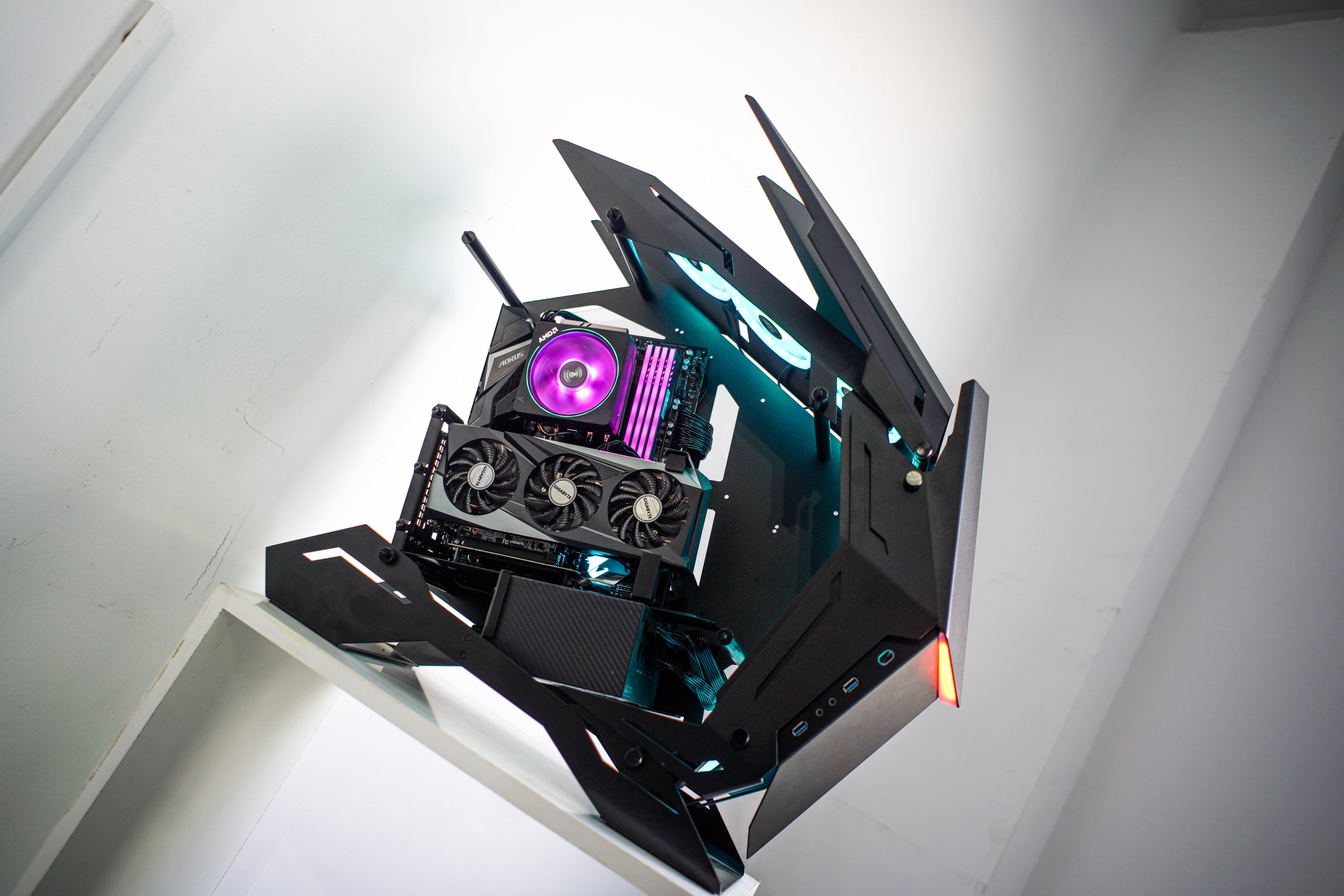AMD vs Nvidia: Who Makes Better Graphics Cards for Gaming?
Brand wars are nothing new in the consumer world: Coca-Cola vs Pepsi, Nike vs Adidas, the Playstation 5 vs the Xbox Series X, Microsoft vs Apple… the list goes on and on.
When it comes to gaming, outside of the general “console wars” perhaps the next biggest rivalry is found between Nvidia GTX, Nvidia RTX, and AMD in the world of GPUs.
Computer hardware enthusiasts are undoubtedly familiar with the decades-old battle between these two industry giants when it comes to creating the best graphics for your gaming devices.
In fact, this competition is so notorious, it’s culturally known now as “Team Red vs Team Green,” with red representing AMD Radeon RX cards and green representing the Nvidia Geforce series. The fight over the best graphics cards continues, with AMD cards and NVIDIA constantly battling for the top spot.
However, this isn’t about popularity or fan service. Today, WTFast is diving into the big question. Who makes better graphics cards for gaming: AMD or Nvidia?
We’ll be looking at everything from gaming performance and price point to specs like refresh rate, CUDA cores, and overclocking that all get you better performance.
Without wasting any time, let’s jump right in!
The Context
These tech titans have been going at it since before the turn of the century, with the advantage generally leaning Nvidia’s way. In recent years, the race has been closer than ever.
In the age of the GPU market shortage, it’s hard to be choosy no matter how we feel about the great GPU debate. However, with prices being as high as they are, it also feels more important than ever to make the right choice and ensure you’re getting the features you want with your next GPU purchase. It’s just as important as choosing an AMD or Intel CPU or choosing between G-Sync and FreeSync.
The latest GPU lines are AMD’s RX 6000 series — the RX 6700 XT, the RX 6800 XT, and the RX 6900 XT — and Nvidia’s Geforce RTX 30 series — the RTX 3070, RTX 3080 and RTX 3090. You’ll often see these quickly selling out on Amazon, Newegg, and other markets due to constantly high demands.
However, beyond these latest series, gamers can also consider going back a generation or two, resulting in well over a dozen options for top-quality GPUs between the two brands depending on your budget and needs.
Judging between our competitors isn’t always as easy or straightforward as one might hope. Specs are a good starting point, but they almost never paint the full picture.
Let’s talk about some of the essential criteria when comparing GPUs.
Performance: Raw Power v.s Experience
In the CPU and GPU conversations, we often talk about “performance,” but what exactly does that mean?
In many ways, we actually mean two different things when we talk about performance. One is the overall experience of using the graphic card (usually during gaming), while the other refers to the raw power capabilities of the card.
Raw Power
We can look at the hard numbers and compare the exact core count, memory, and power requirements, but when it comes to your day-to-day gaming, most gamers won’t notice a difference that relies on raw power.
Of course, these aren’t useless specs. For professional activities such as 3D rendering and AI development, the high-end capabilities of graphics cards are incredibly relevant.
Being aware of the exact capabilities of each card can be useful for gamers in some cases, especially if you’re well versed in computer hardware and want to go exceptionally in-depth in your next PC build or upgrade.
However, for those less invested in the finest details, it’s typically better not to get caught up in every little number. Keep this in mind as we look more closely at the different GPUs available from each brand!
Experience
Raw power might not be the end-all-be-all, but that’s where performance in terms of experience comes into play. The kind of GPU performance most gamers will notice one that prevents FPS drop, lag, screen tear, and similar issues that can take away from your immersion and competitive edge.
This type of performance may be a bit harder to quantify, but user benchmarks typically include rankings that reflect both raw power and overall experience. This means you can get an idea of how users feel when playing with their GPU of choice.
Frankly, the differences are often extremely minimal in this area when it comes to the battle between AMD and Nvidia.
Unless your card is woefully under-specced for your games of choice (ie, three or more generations behind), you will likely be able to run your game at high graphics settings without issue, no matter which brand you choose.
New Technologies
For many gamers, “sufficient” graphics aren’t enough. Modern GPUs do offer much more than just an acceptable frame rate and a decent resolution.
With exciting new advancements such as ray tracing and AI upscaling, it’s now possible to play your games with cinema-quality lighting, at 4K, and at 60 FPS or higher.
This is often a big tipping point when it comes to picking a side between team red and team green. While each brand has its own versions of exciting new technologies, we see that one brand is a clear leader in this area in almost every case.
Those looking for the most innovative, high-end cards might have a clear winner already, but let’s examine these criteria in context for a final verdict.
Is AMD or Nvidia the Best Value For You?
While this may not be the most satisfying answer for some, there is no objective answer regarding which GPU brand is better. Each has its own strengths and weaknesses, and it all comes down to your personal needs.
What’s the most important to your build, and what would bring you the most value?
In an ideal world, we would all have access to the most objectively powerful graphics card without having to consider costs. In the real world, sometimes a GPU with more power at a much higher cost just isn’t worth it.
Raw Power and Performance
When it comes to gaming, there has almost always been a pretty clear winner in the GPU battle. In terms of top-of-the-line, high-end graphics cards, Nvidia has been the dominant force throughout the majority of this race.
At times AMD has been able to challenge their top spot — including with their most recent RX 6900. However, these GPUs generally aren’t recommended for most gamers anyway, as gaming can’t fully take advantage of their power.
The AMD RX 6800 or Nvidia RTX 3080 Ti are the best GPUs in terms of raw power for gaming at a reasonable value. Neither is a totally clear winner in performance, but Nvidia is generally considered a smidge above the rest.
Experience and Value
For gamers building on a budget, raw power is much less important than experience. Everyday gamers should be more concerned with the experience side of graphics card performance, and in this sense, the race is extremely tight.
Chances are, a blind experiment that put gamers behind the keyboard at comparable builds using AMD or Nvidia GPUs wouldn’t be able to tell the difference between them.
At the end of the day, most GPUs released in the latest generations for either brand — whether AMD’s 6000 series or Nvidia’s RTX 30 series — will perform exceptionally well for any game you choose to play at high settings on a 1440p monitor (or even at 4K, in most cases).
With comparable performance in terms of experience, cost becomes the next factor to consider.
Unfortunately, this is an incredibly difficult area to assess at the moment, thanks to the ongoing GPU shortage which has plagued gamers (and other consumer circles) for the better part of two years.
Today, you’re lucky if you’re able to find any of the newer AMD or Nvidia GPUs in stock, let alone at a reasonable price. Most cards are marked up 50% or more from their original list price.
That said, AMD GPUs are generally easier to find in stock at more reasonable prices. That’s mostly due to the higher popularity of Nvidia’s cards.
If you’re looking for a budget to mid-range option, AMD might be better for you right now – although the potential end of the GPU shortage could see Nvidia back to dominate all tiers of GPU value by the end of 2022. We’re just going to have to wait and see.
New Tech Features
This is the real game-changer.
When it comes to the latest tech — namely ray tracing and upscaling — Nvidia is well ahead of AMD. While the latest series of GPUs from both developers include capabilities for each feature, AMD’s submissions are still a ways behind in terms of combining ray tracing with high-resolution gaming at high frame rates.
Looking at most tests, you might find AMD’s GPUs seem to perform just as well as Nvidia cards at 4K… if ray tracing wasn’t turned on. Add that factor in, Nvidia is the only winner, thanks mostly to its DLSS 2.0 capability which helps keep performance high while using ray tracing.
For some gamers, these fancy new features won’t be worth the difference in price. In that sense, the GPU which offers you the most value is really up to you.
Consider which games you play and check whether they support ray tracing in the first place. Also, remember that 4K support means nothing if you haven’t also upgraded to a 4K display.
The Verdict
Ultimately we can’t choose a clear winner because there isn’t one. Nvidia still holds a clear lead in terms of the highest performance gaming at 4K with high FPS and ray tracing enabled. When it comes to everyday gaming, budget, and availability, this race is much closer — with AMD often holding the edge.
Whichever brand you choose for your next GPU, there are still other ways to ensure you have an excellent gaming experience. For online gaming, there’s a new secret weapon: WTFast’s GPN.
If you’re ready to get rid of lag for good, try our network solution to see just how fast and smooth it feels when you use a private, optimized connection for your online game session.
For all things gaming, computer hardware, and more, keep checking back with our WTFast blog!
Sources:
Graphics Processing Unit (GPU) | Investopedia
2022 GPU Benchmark and Graphics Card Comparison Chart | GPUCheck
What Is NVIDIA's DLSS and How Do You Use It? | Make Tech Easier


